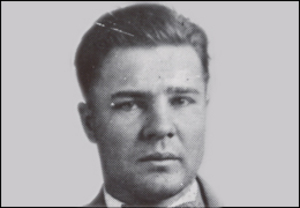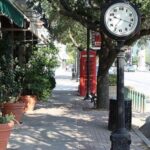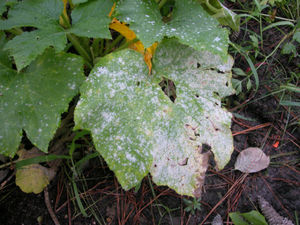Akins Cemetery is a quiet country graveyard located along a rural stretch of State Highway 101, seven miles northeast of Sallisaw, Oklahoma. Set back from the road, the cemetery is nestled in pastureland dotted with the scrubby trees common to this part of the Cookson Hills. The headstones are neatly arranged in sections delineated by a small gravel drive. The place is peaceful and unpretentious, with the only sounds being the wind blowing through the trees and the occasional car on the highway. It seems an unlikely location for a record setting funeral, but that is exactly what happened here on October 28th, 1934. The event is more unusual considering who it was for. It wasn’t for a politician, a movie star, or a famous musician or humorist; rather, it was for a bank robber. The largest funeral in Oklahoma history was for Charles A. Pretty Boy” Floyd, designated by the FBI as “Public Enemy Number One.
FBI agents had gunned down Pretty Boy Floyd on October 22nd, 1934 in an Ohio cornfield. His death ended an unchecked five-year run of robbing banks and avoiding arrest. After being embalmed at an Ohio funeral home, Floyd’s body was sent to Sallisaw, where it arrived on Friday, October 26th. A crowd had already begun to gather in town on the day the body arrived, and thousands lined up outside of the Moore Funeral Home for a chance to file past the open coffin. Throughout that day the crowd grew outside the funeral home to the point that the body was moved to Floyd’s mother’s home, where thousands more waited. People filed past the body at the house until sundown, when the crowd eventually dispersed or was sent away.
However, the crowd returned two days later for the Sunday funeral. Long lines of cars filled the county roads leading to Akins Cemetery hours before the funeral’s scheduled start time of 2:00 p.m, eventually causing a 3-mile traffic jam on the Sallisaw-to-Akins road. By the time that the hearse and funeral coaches arrived, a large crowd of unruly onlookers was present in the cemetery, estimated by witnesses to have numbered between 10,000 and 40,000. The funeral vehicles had to literally push their way through the crowd to reach the small shelter where the service was to be held. Deputies, some of whom had been deputized only days earlier, elbowed and shoved people back to open the hearse and physically removed people from the chairs set aside for the Floyd family. Fifteen volunteer undertakers, gathered from surrounding states, worked to manage the service that despite their efforts assumed a carnival-like atmosphere.
The funeral was described by a newspaper account of the time as “everything a funeral shouldn’t be.” Onlookers trampled flowers and kicked over footstones in an effort to get a better view. Some used tombstones as tables for their lunches while other noisily ate bags of peanuts in full view of the grieving family. When the Reverend W. E. Rockett gave the eulogy, shouts, wisecracks, and laughter from the crowd often drowned out his words. Rockett attempted to curtail the boorish behavior with an admonition but it continued just the same, seemingly without concern for the feelings of the Floyd family. Many of the crowd took things from the cemetery for souvenirs, picking up rocks and flowers and stripping trees nearly bare of bark and leaves.
After the eulogy, people in the crowd clamored to view the body again, and the undertakers allowed a continuous stream of people to walk past the coffin until sundown when the Floyd family requested that the viewing end. The casket was then closed and carried from the shelter to the open grave, and again deputies had to physically move people out of the way to let the casket through. Floyd’s funeral ended with the casket’s interment and the posting of 24 guards that stood watch over the grave overnight.
Such a large turnout for the funeral of a bandit demands an explanation. Pretty Boy Floyd was a bank robber and a murderer (although he likely didn’t kill as many men as the FBI thought he did). Why would so many people want to pay their respects to this man, to the point that it still holds the record for being the largest funeral ever to occur in the state? One of the reasons may have been Floyd’s notoriety. Newspaper and radio reports across the nation romanticized and in some cases exaggerated his exploits, and the FBI declared him “Public Enemy Number One” after the death of John Dillinger. All of this made Floyd a larger-than-life figure, and his funeral may have been a chance for local people to see the burial of a celebrity. In Depression-era Oklahoma, the chance to see someone famous, even in death, were likely very few and, as morbid as it seems, Floyd’s funeral was probably an opportunity for some free entertainment.
Folks may also have been wondering if Pretty Boy Floyd was actually dead. Floyd had thwarted government efforts to catch him for years, successfully avoiding capture by local law enforcement, the FBI, and even the National Guard. Rumors about Floyd’s whereabouts and death were commonplace; he was thought to be overseas, or on the coast negotiating with Hollywood for the rights to make a movie about his life, or dead of blood poisoning or old gunshot wounds. People may have wanted to attend the funeral to see if the Akins boy who had given the law the slip for so long had actually met his end.
But probably the most important reason for such a large gathering of people at Pretty Boy Floyd’s funeral may have been that Floyd was admired. He was a local farm boy who had escaped the desperate poverty of Depression-era Oklahoma and for a while made the big time. He had the wherewithal to successfully plan and carry out over 30 bank robberies, most in broad daylight. For people who could not find work, who had lost their property and possessions and were wondering where the next meal was coming from, Floyd was a hero. Many people were angry at the wealthy and the government during the early 1930s and Floyd successfully struck back at them.
Floyd’s own actions contributed to these feelings of admiration. He once purchased groceries with some of his loot and distributed bushel baskets of food to starving families in the area. It was rumored that Floyd destroyed any outstanding mortgage paperwork in the banks he robbed and that he gave money to several farmers when they were penniless and in dire straits. These actions may have been a strategic effort by Floyd; he may have been purposefully cultivating good feelings among locals and a “Robin Hood”-like persona so that they wouldn’t reveal his whereabouts to law enforcement. On the other hand, by several accounts Floyd cared for his family and the people around his hometown. He may have been simply doing what he could to alleviate the desperate poverty inflicted on the area by the Great Depression. But regardless of his motivation, it appeared to work – despite a reward of several thousand dollars for his capture, those close to Floyd never seriously considered attempting to turn him in for the reward money.
It may never be known for certain what the exact reasons or motivations were that generated the large crowd at Pretty Boy Floyd’s funeral. Harold Brown, a reporter who covertly attended the service (the Floyd family had expressly prohibited the press from attending) wondered if the two day delay between the arrival of the body and the burial was for the purpose of drawing a large crowd, perhaps to bring extra business to town. However, there is no evidence of flyers, barkers, or other advertisements announcing the funeral to support this notion. Rather, it was most likely because Charles Arthur “Pretty Boy” Floyd was a local hero. Floyd took money from the wealthy by force when many people were penniless, homeless, and starving and he shared some of that money with people he knew to be suffering. People admired him for having that kind of spunk. And that admiration, combined with the media’s nationwide publication of his exploits, made Floyd a legend in his own time. He would become a person whose actions would be talked about for generations. Perhaps people realized this and wanted to be part of the legend of Pretty Boy Floyd, if only to play the minor role of a witness to his funeral.
Bibliography:
“Banker Says “Glamor” Adds to Raid Toll,” The Oklahoman, 26 December 1932, p 4.
Brown, Harold. “Crowds Flock to See Floyd; Body is Moved,” The Oklahoman, 27 October 1934, p 1.
Brown, Harold. “Floyd Buried, Other Graves are Trampled,” The Oklahoman, 29 October 1934, p 1.
Capps, Reilly. “Hard Times Romanticize Courteous Outlaw’s Legend,” The Oklahoman, 18 April 1999, p 128.
“Charles Floyd (Pretty Boy),” The Oklahoman, 11 June 1939, p 8.
Collier, Rex. “Pretty Boy Beats the Chair,” The Oklahoman, 6 October 1936, p 4.
“Floyd Slain as he Flees in Ohio,” The Oklahoman, 15 November 1987, p 107.
“Funeral Becomes Gawker’s Show,” The Oklahoman, 18 April 1999, p 128.
Jackson, Ron. “Depression-era Gangsters in Oklahoma,” NewsOK.com.
Lackmeyer, Steve. “Sagebrush Robin Hood An Oklahoma Farm Boy,” The Oklahoman, 24 April 1994, p 168.
Speer, Bonnie L. “Some Dents in Killer’s Legend,” The Oklahoman, 30 May 1982, p 180.
Wallis, Michael. “Floyd, Charles Arthur (1904-1934).” Encyclopedia of Oklahoma History and Culture.
Wallis, Michael. Pretty Boy: The Life and Times of Charles Arthur Floyd. New York: St. Martin’s, 1992.




